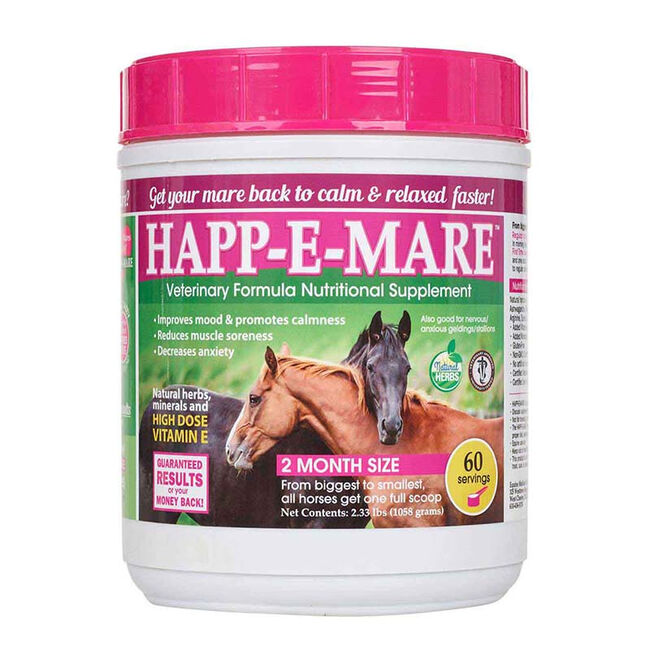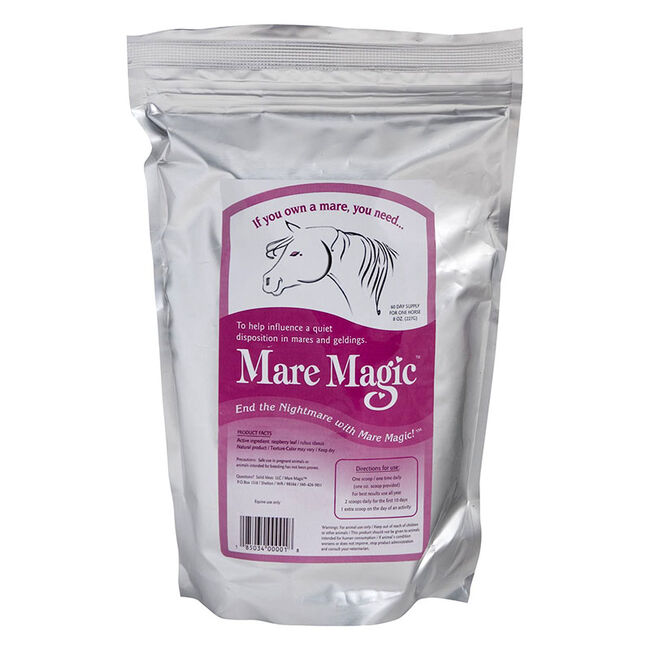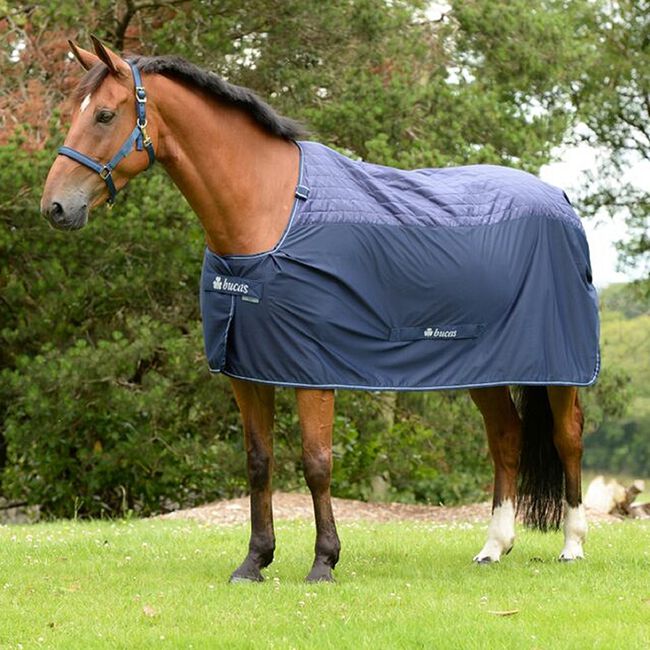Loyal and devoted, mares can be wonderful mounts and companions for equestrians. However, unlike their typically more even-keel gelding counterparts, some mares experience mood swings and a decrease in performance as a result of their estrus cycles. These mares need additional support through their cycles to reduce discomfort and maintain a steady disposition. In this blog, we explore some of the best ways to support your mare through her seasonal cycles when you are riding and/or working with her.
Understanding Your Mare’s Cycle
Mares go through natural hormonal cycles as a part of the reproductive process. The entire 22-28 day cycle is known as the estrous cycle. A mare’s estrous cycle is made up of the estrus and diestrus periods.
At the beginning of the cycle, known as estrus, a mare is receptive to a stallion’s advances and could conceive a foal if bred. Generally, a mare ovulates a day or two before the end of the estrus cycle. This first part of the cycle can last three to seven days and is the time that many equestrians refer to as “coming into heat.” During estrus and the days leading up to it, is when mares tend to exhibit changes in their behavior and physical performance.
After the mare has completed their estrus period, they transition to the diestrus. During this time, the mare is not able to conceive a foal and typically loses interest in stallions. This is also when mares will no longer experience the symptoms of being in heat.
Mares are known as seasonally polyestrous, which means that they have multiple estrus cycles during the spring, summer, and fall. Typically, during the winter months, your mare will not come into heat and will not go through their estrus cycles, this is referred to as the anestrus. This is to prevent foals from being born in the cold weather when they may not be able to thrive. Generally, during this time period, your mare will be unreceptive to male horses and tend not to have the mood swings and physical changes that accompany the estrus cycles.
The Effects of Your Mare’s Cycle
When your mare comes into heat, she may exhibit a number of different symptoms. Typically you will see a change in her behavior, which many equestrians see as mood swings. Additionally, signs of your mare coming into heat (or the estrus cycle) include:
- Tail raising and “winking” their vulva at other horses
- Frequent urination
- Increased interest in other horses
- Squealing
- Signs of aggression (biting, kicking stall walls, grating teeth on stall bars, etc.)
- Change in behavior towards horses and humans
- Irritability
- Anxiety
- Overly reactive
- Easily distracted, often screaming for other horses
- More sensitive than usual to touch (may not enjoy being brushed)
- Less active than usual
- Sore muscles (particularly lower backs and over the loins)
- Swollen teats/mammary glands
- Change in appetite
Riding or working with your mare may also be more challenging when mares are in heat. Often they are grumpier, especially to the leg aids, and may not have the same work ethic that they typically have. Many mares also experience stiff backs, cramping, and tight muscling, which can make it painful to stretch correctly over their backs while under saddle.
Supporting a Mare Through Her Cycle
It is important to note that while your mare may be moodier and more temperamental than usual when she is in season, these changes are due to factors outside of her control. Many mares respond well to decreased workloads with activities that keep her focused under saddle. During the estrus period, it is often wise to go back to basics and work on suppling exercises to help your mare stretch her back and find comfort in her body. You may find that this is a great time to bring your mare on hacks on the trail or working on your walk movements. Many equestrians find that adding additional padding (in the form of cushioned therapeutic saddle pads) may help to decrease their mare’s back sensitivity or discomfort under saddle.
It goes without saying, but your mare should be kept away from stallions when she is in heat to avoid unwanted pregnancies. Horses have been known to become pregnant even when mares and stallions are in separate pastures, so it is important that they do not share any fence lines. She may be more reactive to other horses as well, so it may make sense to separate her from other horses completely if you find that she is becoming aggressive toward them. Furthermore, there are several other ways that you can support your mare:
Change of Routines: One of the easiest ways to support your mare is to modify her daily routine. Whenever possible, allow her to be turned out so that she can stretch her muscles and move in a way that feels good to her. You may want to keep her away from other horses, since this may exacerbate her heat symptoms. If you find that her frequent urination is causing irritation on her legs, teats, or private areas, you will want to bathe her with a gentle cleanser, such as the Equiderma Sheath, Udder, and Genital Cleanser or the Hay Where’s That Winky Wash -N- Udder Stuff.
Udder Stuff
Hay Where’s That
Mare Support Supplements: There are a number of all-natural supplements that can support your mare and assist in the painful heat symptoms. Supplements such as Hilton Herbs Easy Mare Gold, Silver Lining Herbs Mare Moods, and Equine Medical & Surgical Happ-E-Mare can help to regulate your mare’s mood, decrease anxiety, and keep your mare comfortable (particularly pain and inflammation).
Happ-E-Mare Supplement
Equine Medical & Surgical
Many of the formulas contain Chaste tree berries, which have been shown to stimulate progesterone production in the pituitary gland, which may help balance your mare’s hormonal levels. Uckele Chasteberry Extract is an affordable option that utilizes this ageless remedy.
Chamomile Flower is another common ingredient, offering the same comfort that many women experience when they drink chamomile tea during their menstrual cycle, minimizing cramping and bloating. Vervain, cramp bark, yarrow, rosemary, and lemon balm are all herbal ingredients that may relax the uterine muscle and limit spasming/cramping.
For optimal results, your mare should be kept on these supplements year-round, not just when they are experiencing active estrus. Unlike hormonal therapy, these supplements will not prevent your mare from coming into heat, but they can help to minimize the symptoms. If you choose to utilize these products and will be competing with your horse, make sure to check the ingredients against the prohibited substances list to ensure that you comply with the rules and regulations.
Raspberry Leaf: One of the most common herbs seen in supplements can also be fed in conjunction with other supplements. Raspberry leaf is the active ingredient in Mare Magic and Foxden Equine Stability EQ, some of the most popular mare support supplements that we carry. This beneficial herb is also frequently used for pregnant women; it has been known to help alleviate the effects of hormonal changes. Studies have shown that raspberry leaf strengthens the uterus as well as the pelvic muscles, this may minimize the discomfort that your mare feels when she is in heat and could potentially make cramping less severe.
Anti-Inflammatory Medications: Going into heat can be painful for your mare, especially if they are in a consistent program of upper-level work. If you find that your mare is especially moody under saddle, you may want to consider that this is pain-related. Sometimes this is due to tight muscles or sore ovaries. If this is the case for your mare, your veterinarian may recommend a non-steroidal anti-inflammatory (such as flunixin meglumine) to minimize your horse’s discomfort.
Therapeutic Blankets: In recent years, new innovations in technical fabrics have become more mainstream in the equestrian community. One of these advancements is the adoption of therapeutic fabrics that stimulate blood flow and, therefore, help to decrease inflammation. Utilizing a therapeutic blanket, such as the Back on Track Therapeutic Turnout Sheet or the Bucas Recuptex Therapeutic Blanket, can help to soothe your mare’s tight back and sore muscles over the course of her cycle.
Massage: Many mares brace themselves over their backs to protect their sensitive ovaries during their heat cycle. The result is a tight, tense back with sore muscling (it can also extend to the hindquarters depending on the severity of the pain), which can make under saddle work quite painful for your mare. Gentle massage over the area can help to reduce tension in the area and help to loosen the muscles. Many mares enjoy being massaged with the Partrade Gel Groomer Massage Mitt with Magnetic Rollers or the Dressager Equine Massage Roller. We encourage you to watch this short video to learn more about equine massage during your mare’s cycle or to refer to our blog post about more generalized information about massage and the benefits of this hands-on therapy, An Educated Touch: An Introduction to Equine Massage.
Liniment Brace: A relaxing liniment brace can release tension from your mare’s sore muscles, while also giving her coat a gorgeous shine (your mare will appreciate the pampering and relief of tightness). Simply mix a small amount of liniment, like Back on Track Limber Up LiniMint or Arenus/Equilite Sore No-More Liniment, into a bucket with some water and then gently sponge over all of the major muscle groups, avoiding the eyes, nose, and any open wounds. This will help to stimulate the circulation in the muscles and help your mare’s muscles to be more comfortable, loose, and supple.
Hormonal Medications: There are two popular hormones that can be given to horses to suppress their heat cycles. These are often utilized by horse owners who have horses that experience severe signs of being in heat as well as equestrians who have their mares in a rigorous competition schedule that does not allow them to have much downtime. The most common medications prescribed to manage a mare’s heat cycle are Altrenogest (Regu-Mate), which is given orally, and Medroxyprogesterone acetate (MPA, Depo-Provera), which is given intravenously. However, only Altrenogest is currently approved by the Food and Drug Administration (FDA) for use in horses.
Regu-Mate is one of the more popular hormonal treatments; giving it to your mare daily will reliably prevent her from coming into heat. Once you stop giving it to your mare, she will begin to cycle again. It is highly effective, yet, it has its downsides as well. Regu-Mate is much more expensive than the other options, it also needs to be handled with extreme caution. It is especially risky for pregnant women, teenage girls, and women of childbearing age. Additionally, it can exacerbate hormonal conditions and uterine problems, such as tumors and infections. These medications should only be used under the guidance of a veterinarian.

Ovariectomy: Only to be used as a last resort, this is the surgical removal of your mare’s ovaries (or “spaying” your mare). This will prevent her from manufacturing eggs and therefore remove her estrus cycles. This is major surgery and should only be considered under the guidance of a trusted veterinarian. It is important to understand that while this will eliminate your mare’s heat cycles, they still may experience other hormone-related issues.
Owning a mare can come with its challenges, but, generally, they are incredible partners that are willing to please and try their hardest. In fact, Lindsay Paulsen said in a recent Dressage Today article, “Once you have won a mare’s heart, you have won all of her. In exchange for your best—and nothing less—she will give you everything.” While it may take a bit of patience to figure out how to manage your mare’s heat cycle, it will be well worth it as you develop an incredible equine partner.




